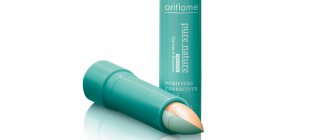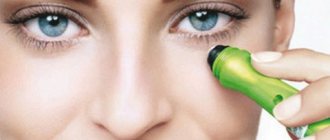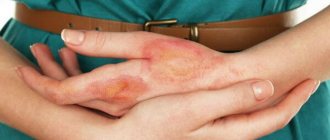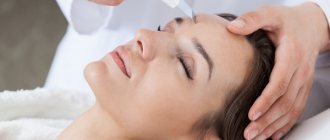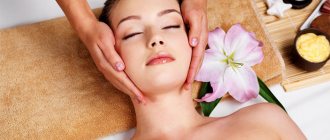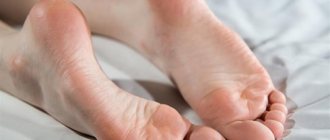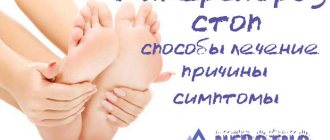In this article we will talk about the causes and methods of treating cracks in the fingers. You will learn which medications help quickly eliminate discomfort and heal wounds. After reading, you can easily cope with this problem at home.
Cracks on the hands are shallow tears in the skin that appear on the fingers, between them, on the wrists or on the palms. Often the skin cracks in the spaces between the fingers, since here it is most delicate, regularly bends and is exposed to external influences. The rupture occurs along the elastic fibers lying under the skin.
Prevention of rough skin on hands
Prevention is aimed, first of all, at eliminating the cause of roughening of the skin. To prevent the development of hyperkeratosis on the palms and fingers, it is enough to constantly adhere to the following recommendations:
Regular hand baths help prevent rough skin
- Receipt of all necessary vitamins and microelements into the body in the proper quantities and at the right time. For the beauty of the skin, one should not so much influence it with external means, but rather ensure the presence of building blocks for its renewal. These building blocks are proteins, amino acids, vitamins and minerals.
- Protection of hand skin from external aggressive influences. There are many factors that worsen skin condition. Among them, solar radiation, wind, cold in winter and chemicals are especially dangerous. They make the skin rough. You should wear warm gloves in winter and rubber gloves when doing housework. Hands should be periodically lubricated with moisturizing creams with UV filters.
- It is advisable not to wash your hands with hard soaps; it is better to change them to natural or liquid ones with the addition of moisturizing ingredients and natural oils. After washing your hands, you should wipe them dry with a towel using blotting movements; you should absolutely not go outside with wet hands.
- You need to get a manicure and various beauty treatments regularly. You don't have to do this in a salon. There are many tools that allow you to take care of your hands at home and prevent roughness. These are compresses, hand baths, masks.
What to do if your hands are dry
First you need to understand that dry hand skin is a temporary problem. The situation can be easily corrected if you follow useful tips and try to avoid dangerous factors in the future. Let's look at how to get rid of dry hand skin:
- if the problem is critical: there are deep cracks, calluses, wounds, the skin is very flaky - you should contact a dermatologist or cosmetologist to select effective restorative therapy;
- if the skin is simply dry and does not look very beautiful, various creams, therapeutic masks and oils will certainly help you.
Vitamins for dry hands
If the cause of dryness is seasonal disorders of the body, then vitamins are a mandatory element to get rid of the problem. Vitamins B, A, C, E help best for hydration. It is necessary to include in the diet foods rich in essential substances: liver, fatty red fish, nuts, herbs, fruits. Water balance is important: you need to drink a lot of clean liquid a day and do not drink alcohol. Vitamins for dry hand skin can be taken in capsules, in the form of ready-made complexes.
Treatment
The following masks, compresses and procedures help to soften the skin on the fingers and palms:
- Masks based on natural oils, honey and lemon. It is better to take cold-pressed oils. Excellent results are obtained from grape seed oil, almond oil, flaxseed oil, and burdock oil. Honey has also long been famous for its magical effect on rough skin. Lemon softens, whitens and improves the permeability of the dermis. Mix all ingredients in equal parts, heat slightly and apply to hands. Leave for twenty minutes, then rinse and apply moisturizer to your hands.
- Baths and compresses from decoctions and infusions of herbs. Herbs such as calendula, chamomile, mint, and string have a good effect. The herbs should be poured with boiling water and allowed to brew for about fifteen minutes, then dip your hands into the infusion and hold for the same amount of time. Then the skin should be lubricated with cream. If the skin of your hands is dry, you should carry out such procedures at least two to three times a week. An excellent result will not take long to arrive.
- Massage is also beneficial for the hands and skin of the fingers. When applying the cream several times a day, you should devote just a few minutes to a light massage. First you should stretch your fingers, then move on to your palms. The movements should resemble putting on gloves.
There is no need to treat the rough skin of your hands as a trifle, because it is with this phenomenon that many pathological processes begin. Rough skin can become cracked, peel, and cause not only physical discomfort, but also mental suffering.
There is nothing good in a situation where a woman is ashamed of her hands and hides them in her pockets or behind the long sleeves of her clothes. You can and should be proud of your own hands. And to have such an opportunity, it will not take much time and money. Literally ten to fifteen minutes a day and the simplest ingredients are enough to forever forget about such an unpleasant problem as hyperkeratosis of the hands.
Every person wants to have beautiful and well-groomed hands, because this part of the body is almost always open for display to others. However, the skin of the hands experiences significant stress - prolonged exposure to wind and frost, regular contact with synthetic detergents, wearing thick clothes and outfits made of artificial materials. Horny hand skin can also be a consequence of metabolic disorders, a lack of vitamins and microelements in the body, or improper care. Based on this information, we can identify some methods for preventing the appearance of keratinized skin on the hands.
Prevention:
- a balanced and rational diet containing plenty of vegetables and fruits;
- wearing loose clothing made from natural materials;
- protecting the skin of your hands from contact with detergents and from unpleasant weather conditions using gloves;
- using soap with added cream or moisturizing ingredients;
- regular use of nourishing creams and lotions against keratinized skin on the fingers containing natural ingredients (shea butter, jojoba extract, calendula or chamomile, etc.);
- mandatory wiping of hands dry;
- carrying out timely manicure and pedicure procedures.
When treating keratinized skin of the hands, fingers and elbows at home, it is customary to use masks, baths or compresses. All of them are prepared from natural ingredients and are quite effective.
Compresses against keratinized skin of the elbows
Cabbage compress
. To soften the epidermis, a paste of grated cabbage leaves is applied to the keratinized skin on the elbows, wrapped on top with plastic wrap and a warm cloth. The compress is kept for about 20 minutes, after which the forehead is washed off with warm water and lubricated with a nourishing cream. This procedure will give the skin smoothness and elasticity, and restore its healthy color. The best effect is achieved when using the method twice a week in the summer and once in the winter.
Kefir compress
. Add one teaspoon of eucalyptus or geranium oil to half a glass of kefir. Mix the mixture well and apply it to the keratinized skin on the elbows. Just like in the previous case, use cellophane and fabric. After 15 minutes, rinse the compress with water and lubricate the skin with cream.
Oil compress
. Heat the vegetable oil to body temperature and dip your elbows in it for a few minutes. Then, using a pumice stone, remove areas of keratinized skin on the elbows and lubricate the cover with a rich cream to make the epidermis soft and smooth.
Masks for dead skin on fingers
Potato-honey
. To one grated raw potato add a few drops of lemon juice and a teaspoon of honey. Apply the paste to the keratinized skin of your hands for 15-20 minutes, then rinse with water. This mask perfectly smoothes and softens the skin of the hands.
Corn-olive
. Mix two tablespoons of olive oil with a tablespoon of corn flour. Apply the resulting composition to the skin for 5-10 minutes, and then rinse with warm water. This rejuvenating mask perfectly tones the skin of your hands.
Oatmeal.
Grind a handful of oatmeal, add a tablespoon of aloe juice to it and knead until mushy. Apply the mixture to the keratinized skin on the fingers and palms and rub it in for five minutes. After this, your hands should be rinsed with warm water and wiped dry.
Softening baths against keratinized hand skin
Soda
. Mix two teaspoons of baking soda in a glass of water, pour the liquid into a bowl and soak your hands in it for 5 minutes. At the end of the session, wipe your hands dry. The skin will become smooth and pleasant to the touch.
Bran
. Soak a handful of bran in a glass of boiling water. When the liquid has cooled to body temperature, you need to lower your hands there for 5 minutes. Then wash your hands with warm water.
Soapy
. Grate a quarter of a piece of laundry or tar soap and add it to a bowl of warm water. Keep your hands there for 20 minutes, then rinse and dry them.
All of the above procedures are best done before bed.
The skin is the most important organ that prevents infection by various infections and viruses. Contact with poor quality water, aggressive substances, prolonged exposure to cold and many other factors provoke cracks in the fingers. In addition to its unpleasant appearance, the disease causes severe pain and itching. The problem often signals the development of diseases that need treatment. In this case, you need to undergo a full diagnosis from specialists to identify the failure.
It is strongly recommended to find out why cracks appeared on your hands and what could have caused them. Most often, dryness can be noticed after contact with aggressive substances during cleaning or prolonged exposure to the street in frosty weather. Provoking factors are:
- Working with aggressive substances. Prolonged exposure of the dermis to paint, laundry detergent, detergent or alkaline soap causes irritation. After some time, red spots, peeling and even wounds appear on the hands.
- Neglecting hand care. In late autumn, winter and early spring, you should use a moisturizer, since exposure to wind or frost causes the protective film on the surface to become thinner. Nourishing cream for cracked fingers will provide additional protection and maintain the elasticity of the epidermis.
- Mechanical injuries. Frequent finger injuries in people who regularly work with cutting objects cause changes in the structure of the skin. Over time, the cuts do not heal completely and small scars and cracks form.
- Working with the earth. “Gardener’s hands” - the problem appears in adults who come into contact with the ground without using gloves. Often, rough, dry skin with small cuts can be noticed in spring and autumn. The same factor includes hard water, which also negatively affects the appearance of your hands.
- Poor nutrition or lack of vitamins. Diets and fasting cause a lack of useful elements in the body. For rapid cell regeneration, vitamins A, E, B7, as well as magnesium are required. If they are missing, then the epidermis throughout the body becomes sensitive and vulnerable to any injury.
What to do if none of the provoking factors could cause the defect? In this case, you need to think about possible internal violations. Many diseases are characterized by cracking of the skin. It is worth thinking about the following pathologies:
In addition, ichthyosis and Reiter's syndrome can affect the appearance of the hands. The first will be indicated by rough skin, similar to scales, which cracks when pressed. The disease can be congenital or acquired. The peak incidence is diagnosed in winter. Reiter's syndrome manifests itself in damage to the genitourinary, skeletal and muscular systems, as well as the mucous membranes and epidermis. Rashes, thickened skin, dryness and cracks are noticeable on the extremities.
Treatments for chapped hands
Let's look at what to do with rough hands at home. Among the procedures that are recommended to be carried out at home, the following should be noted:
- A bath with the addition of nourishing ingredients moisturizes and relieves irritation. To prepare it, you can add olive oil and a little lemon juice to warm water. Remember that the bath temperature should not be too high. Immerse your hands in it for 15 minutes. It is recommended not to wash them after the procedure, but to carefully dry them with a towel, leaving a thin layer of oil.
- The hand scrub exfoliates the dead and stratum corneum of the epidermis and prepares it for further procedures. A homemade scrub can be made by mixing coarse sugar, such as brown sugar, with a few tablespoons of olive oil, honey and lemon juice. Sugar can also be replaced with sea salt, ground oatmeal, coffee.
- Hand mask - for example, boiled and chopped potatoes with the addition of yolks and warm milk have a nourishing and smoothing effect. The mask should be kept on the skin for about 15 minutes, preferably under food foil for better penetration of the active ingredients, and then rinsed off with warm water.
A good home remedy for getting rid of rough skin on your hands is also to lubricate them with cocoa butter, lanolin, petroleum jelly, mineral or vegetable oils such as argan and coconut.
Remember that all hand treatments, regardless of whether they are performed at home or in a beauty salon, will give the best and lasting effect only if you carry them out regularly. You should take care of dry hand skin at home 1-2 times a week, and once every 2-3 months, afford professional treatment performed by an experienced cosmetologist.
Danger of illness
Inflammation of the joints of the fingers
Inflammation of the phalanx of the finger not only indicates the development of serious diseases, but is also considered a dangerous phenomenon. Pathogenic bacteria or infections easily penetrate through damage in the dermis, causing suppuration and inflammatory processes in the tissues. As a result, a fungal disease of smooth skin or nails develops. Painful cracks in the skin of the fingers prevent you from doing any work normally. If the wounds are not healed in time, then over time a new failure may occur in the weakened body and cause destruction of the nail plates. In addition, it is possible to develop felon, an acute disease that affects the soft tissues of the fingers. Causes severe pain and purulent processes.
Localization of damage and symptoms
You can notice painful lesions everywhere. They occur on the folds of the outer or inner side of the palm, near the knuckles and nails, on the pads or between the fingers on the dermis. All injuries cause discomfort when moving your hands or coming into contact with water.
A person feels the greatest discomfort if peeling skin on the fingers has formed in the folds or on the pads. Even light contact with any object causes burning and itching due to stretching of the epidermis. Inadequate treatment of pathology worsens the structure of the skin, making it dry and thin. For this reason, breaks do not heal for a long time, but only increase in size. Calluses often appear on the pads, which are followed by cracking. Prolonged inflammation can signal the onset of eczema or diabetes. With psoriasis, cracks mainly appear on the arms and legs.
Damage on the fingers near the nails and under them indicates a lack of vitamins A, E, and B, as well as fungal infection of the tissues. Cracking or convergence of the nail plate, suppuration and change in skin tone are diagnosed. Vitamin deficiency does not cause pain, redness or itching. You only feel roughness, dryness of the hands and cracking of the dermis. An allergic reaction manifests itself in itching, burning and swelling. Healthy, elastic skin can change to rough skin after prolonged contact with water, dust or soil.
Non-bleeding cracks on the fingertips are a negative result of long-term therapy with antibiotics or hormonal agents. The occurrence of symptoms such as the discharge of blood or pus, severe itching, deep cracks and changes in skin color indicate diseases of the internal organs. You should definitely visit an endocrinologist, surgeon or dermatologist to identify the cause of the damage.
Cracked skin on the hands - what are the reasons?
Dry and cracked skin on the hands is a problem that arises with the arrival of cold weather. Frost and wind contribute to the aggravation of painful diseases. In addition, freezing temperatures and staying in heated rooms with low humidity damage sensitive and dry skin on the hands. However, there are many more reasons that determine the occurrence of this problem.
Cracked skin appears mainly on the fingers, especially around the pads. This is quite a big aesthetic problem, sometimes very painful.
The main reasons why hands become rough are as follows:
- External. Very low temperatures (they cause rapid evaporation of water from the epidermis), frostbite (further increasing the problem by causing irritation), detergents, frequent contact with water (especially hot water), improper skin care, hard water, unbalanced diet, consumption of too little amount of liquid.
- Internal. Skin diseases such as psoriasis, eczema, mycosis of the skin, systemic diseases, allergies, vitamin deficiency (especially vitamin A), reduced immunity.
Causes of cracks between the toes may include previous fungal infections, use of antibiotics and immunosuppressants, HIV, cancer, kidney failure and hyperthyroidism.
Most often, rough skin on the hands appears in men. This is due to the fact that they have a thicker stratum corneum of the epidermis, and not all of them like to regularly use creams and balms.
Treatment options
It is highly undesirable to resort to medications without consulting a specialist. Before contacting a doctor, you can only use moisturizers: nourishing cream, essential oil or Vaseline. Self-administration of medications will relieve symptoms and the examination results will be unreliable. In addition, the wrong drug often provokes deterioration.
Panthenol
For creams for healing cracked hands, it is recommended to use cosmetic products without alcohol and artificial moisturizers. The most effective natural substances are lanolin, essential oils of jojoba, coconut, sea buckthorn, shea or tea tree. Examples of creams: Bioderma, Rilana, Newtrogina, Dachnitsa and Biocon. Among pharmaceutical products, Bepanten, Panthenol, Solcoseryl ointment and Apilak will have a therapeutic effect on small wounds.
The famous Vishnevsky ointment helps with burns, purulent wounds and cracks on the body. You should not refuse the product because of the unpleasant odor, as it really helps relieve inflammation and restore the dermis. It should be applied several times a day to the affected areas. Ichthyol ointment, Levomekol and Dexpanthenol have similar effects. Boro Plus cream in pink or green packaging has a more neutral scent. You will have to use it to heal cracks on your hands 3-4 times a day, since the product is well absorbed and quickly washed off with water.
Expert opinion
Meshcherinka Diana
Dermatologist of the first qualification category
Wounds should be treated with antiseptic agents - Miramistin, hydrogen peroxide, furatsilin solution. If there is a large amount of blood or pus, then bandages with disinfecting ointments should be applied. It is not recommended to take antibacterial drugs without a doctor's prescription. They have not only positive but also negative effects.
For diseases of the internal organs, certain medications are prescribed for a particular disorder. For example, Radevit, Actovegin or Methyluracil are used to stimulate metabolism. Fungal infections of nails and skin are treated with antimycotic drugs in the form of ointments or tablets. It is recommended to choose Clotrimazole or Pimafucin, as they do not cause side effects and have a wide spectrum of action. It is possible to alleviate the condition of eczema and psoriasis by using ointments based on Prednisolone.
Cracks on the fingers near the nails that are caused by an allergic reaction should be treated with antihistamines. It is necessary to exclude even minimal contact with the irritant. To relieve itching, burning and swelling, internal tablets are prescribed - Loratadine, Suprastin or Cetirizine. In addition, it is allowed to smear the affected areas with Psilo-balm.
The skin on the fingers near the nails is cracking. Internal factors
1. Disruption of the thyroid gland - if a person has an abnormal metabolism, then many systems of the body suffer. The skin of the hands also begins to crack, and deep and painful wounds appear near the nails. Hormonal disorders include: diabetes, hypothyroidism and other diseases of the endocrine system.
2. Lack of vitamins and mineral elements - cracks in the hands indicate a lack of vitamin A, B7, E, Omega-3 and magnesium. Using alkaline soap in these cases will only make the situation worse.
3. Skin diseases - they can be infectious (fungal infections) and non-infectious (eczema or psoriasis) in nature. Diseases of the skin lead to the appearance of deep cracks around the nails, between the fingers, and on the palms.
4. Helminthiasis - the presence of any parasites inhibits physical development when it comes to a child. Adults cannot gain weight if they have an increased appetite. In addition, helminths can lead to allergic reactions, rashes and dry skin. All this causes cracks to appear on the hands.
5. Chronic diseases - pathologies of the gastrointestinal tract (gastritis, cholecystitis), neurological diseases (neurosis, depressive states) suppress the immune system. One of the main symptoms is the appearance of cracks around the nails.
As a result of internal factors, the skin of the hands is affected. Cracks and ulcers appear not only around the nails, but also on the palms, between the fingers, and on the phalanges of the fingers. Wounds cause pain, especially when interacting with water or chemicals, or due to temperature changes. Often, ichor can be seen on the affected areas.
It is important! The use of cosmetics in this case will only reduce pain and partially eliminate unpleasant symptoms. But for a complete recovery you need to undergo treatment. It is individual and depends on what the person is sick with.
How to do without the help of a doctor
How to treat cracks in fingers without specialist advice? Sometimes it happens that it is not possible to visit a doctor at the moment. It’s easy to alleviate the condition, learn about simple remedies. BF-6 medical glue will help seal deep wounds. It is absolutely safe and does not cause suppuration or allergies. The product can only be used to treat dry skin without pus or blood. A small amount of glue is applied to the crack and wait a few minutes, during which it dries. Cracks heal faster, since their edges are fixed and do not diverge further. In addition, no water or pollution gets into them, which also speeds up recovery. From time to time, damage to the finger is glued, if necessary. After such therapy, it is recommended to apply a moisturizer.
Sulfacrylate has a similar effect. It is applied to the affected areas, dries and forms an invisible film. It needs to be applied more often than medical glue, but the drug also has a healing effect. Its composition ensures the destruction of pathogenic organisms and relieves inflammation.
Many dermatologist patients complain of quickly, within a few days, keratinization of the skin on their fingers. Since in the first period of the disease most people try to eliminate this defect on their own, using warm baths and rich creams, they see a doctor only when deep, painful cracks form on the skin. Hyperkeratosis is a general name for a whole group of diseases that cause this symptom, some of them are very serious. This disease is characterized by disruption of the epidermis, an increase in the layer of dead cells and the formation of areas covered with the stratum corneum.
Treatment with medications
The course of treatment depends on the reason why cracks appeared on the hands. If discomfort is caused by external irritants, use healing agents and moisturizers. For diseases of internal organs, complex therapy will be required.
Drugs for symptomatic therapy
The preparations are excellent for protecting the skin of the hands from external adverse influences. This group of medications is aimed exclusively at healing existing cracks, without eliminating internal causes.
- "Glue BF-6" . Alcohol-based antiseptic and wound-healing drug. Indications for use are wounds, cuts, cracks. Apply a thin layer of glue to the damaged surface. Within 2-5 days, a strong film forms on the skin, tightening the edges of the wound and isolating it from infection. Do not use glue if you are individually sensitive to the components and for treating children under 1 year of age.
- Cream "Zorka". A crack-healing agent based on floralizin, an extract from fungal mycelium and phospholipids. Although this drug belongs to the veterinary group, dermatologists have long prescribed it to patients to combat psoriasis, dermatitis and other external skin lesions. Apply the cream 2-3 times a day, applying a thin layer to the affected skin. An analogue of “Zorka” is the cream “Forest Power”.
- "Fingerfix" . A remedy for cracked hands based on zinc oxide, olive oil, soybean oil, paraffin and lecithin. The cream creates a protective film on the skin, protecting it from external influences. The product promotes rapid skin restoration. Apply it to the affected surface, avoiding contact with eyes.
- "Bepanten" . Cream with pantothenic acid intended for healing cracks and treating dry skin. Apply Bepanten to the affected areas 2-3 times a day.
- "Rescuer" . Ointment with fir and olive oils. Effectively moisturizes, fights germs, soothes, heals and protects the skin from external influences. Apply a thick layer to your hands and repeat the procedure after the balm is absorbed.
Important! In the presence of serious diseases of internal organs, these funds can only be used as part of complex treatment.
Complex therapy
Cracks in the hands, which are a symptom of an internal disease, must be treated by eliminating the underlying cause.
- Contact dermatitis . Since the allergic reaction is based on an increase in histamine, antihistamines are prescribed internally: Erius, Zyrtec, Suprastin, Tavegil and others. Local treatment is carried out using corticosteroid ointments with an anti-inflammatory effect “Advantan”, “Lokoid”, as well as “Hydrocortisone ointment”. Apply a thin layer to the affected area once a day. Similar drugs are used for eczema.
- Fungal infection . Treatment of fungus begins with oral administration of antimycotic drugs: Ketoconazole, Fluconazole. Local treatment is carried out with antifungal ointments “Candide”, “Nizoral”, “Zalain”, “Lamisil”, “Miconazole”, “Salicylic ointment”.
- Vitamin deficiency . To compensate for the lack of vitamins, doctors prescribe vitamin complexes, for example, Vitrum, Alphabet and others. Local treatment consists of nourishing the skin, for which Radevit cream with fat-soluble vitamins A, E, D is ideal. You can prepare the cream yourself by mixing 1 ml of lemon juice, aloe juice, liquid vitamins A, E (can be bought at the pharmacy ), glycerin and lanolin. Lubricate your hands with it at night.
- Atopic dermatitis . The disease is treated with steroid ointments for healing (Advantan, Lokoid), systemic glucocorticosteroids in the form of injections (Diprospan), orally (Prednisolone, Dexamethasone), psychotropic drugs to relieve nervous irritation due to itching (Atarax "), "Cyclosporine A".
Atopic dermatitis occurs not only in adults, but also in young children. Therefore, you should know how to treat it safely, and which drugs can cause serious harm to the body.
- Psoriasis . For minor lesions, hormonal ointments are used that give a faster and more lasting effect (Flucinar, Advantan, Cloveit, Ekolom, Akriderm, Hydrocortisone and others). For large areas of the body affected by psoriasis, non-hormonal ointments are used: salicylic, ichthyol, dermatol, cartolin, sulfur-salicylic, as well as drugs for local treatment: Elidel, Daivonex, Zinocap, Skin-cap.
- Reiter's syndrome . Skin damage in this disease is secondary and is only one of the symptoms. Complex treatment includes a course of antibiotics, immunomodulating drugs, hormonal therapy, and physical therapy. To heal cracks, use moisturizing creams such as “Yaka” with apricot and argan oils (creates a protective film on the skin, which speeds up healing) or “Tenderness” from Oriflame with macadamia oil.
- Ichthyosis . With ichthyosis, water-fat metabolism is disrupted. The skin becomes dry and cracks. To avoid the formation of wounds, lubricate the skin with petroleum jelly, lanolin, retinol, almond or coconut oil. Among the drugs, “Losterin”, “Prednisolone”, “Prednicarb” help quite well.
- Hypothyroidism . In case of thyroid dysfunction, doctors prescribe iodine preparations (Iodomarin), hormonal medications (Eutirox, L-thyroxine). Cracks in the hands are only a consequence of improper metabolism. After a course of replacement therapy they disappear. For quick healing, use any moisturizing, healing cream, for example, “Healer with Aloe” based on aloin.
- Diabetes . The disease is based on disturbances in the endocrine system. Along with insulin therapy, to eliminate dry skin, use Ureata, DiaDerm Cream-Talc, and Virta creams with urea. When choosing hand products, purchase ointments and creams marked “for diabetics.”
- Sjögren's syndrome . Basic therapy is carried out with the drug "Chlorbutin" or "Cyclophosphamide", which is used for several years. To combat dry skin, any hand moisturizer from foreign, Nivea or domestic Kalina, Nevskaya Cosmetics and others is suitable.
Important! It is necessary to use hormonal drugs and undergo treatment for diseases of internal organs only after laboratory tests and confirmation of the diagnosis.
Causes of hyperkeratosis
Excessive proliferation of skin surface cells has many causes, both mechanical and pathological. Rough skin on the fingers is often observed in people whose professions involve daily pressure on these areas, for example, shoemakers or guitarists. The areas of skin that come into contact with the strings become horny, forming a layer of cells and protecting the skin. Workers who constantly deal with resins, sand or tar suffer from excessive cell growth on the fingers and palms, and this is dangerous because the degeneration of such cells can cause a malignant skin disease.
Age-related changes in hormonal levels entail keratoderma: during menopause, some women develop skin layers on the palms and fingers, they are diffusely located and have a grayish or yellowish color. Sometimes keratinization becomes covered with deep, painful cracks. Senile lumps and plaques on the hands usually do not bother their owners, but there is a risk of such cells degenerating into cancer.
Horny skin on the fingers of children and adolescents is a symptom of a serious illness, so keratoderma is most often caused by a gene mutation. Provoking factors can be various viral diseases, hormonal imbalances, a lack of vitamin A in the body, and the cause of the deficiency can be both external and internal. Poor nutrition and diseases of the digestive system, cancer and metabolic disorders are the main reasons for incomplete absorption of vitamin A, which in turn provokes keratosis.
The cause of the proliferation of epithelial cells is sometimes an allergic reaction to a cosmetic product or washing powder. Excessive consumption of food allergens also causes the appearance of horny layers of cells.
Causes
To choose the optimal treatment, you need to understand the causes of the problem. They are internal and external.
External
- Using household chemicals without using protective gloves . Antibacterial soap, dishwashing detergent, bleach, washing powder, etc. dry the skin. It loses elasticity, becomes rough and cracks quickly.
- Exposure to ultraviolet radiation . Prolonged exposure to sunlight has a negative effect on the condition of the skin. They dry out and small linear cracks appear on the skin.
- Sudden change in temperature . Working in hot water when washing, staying in the cold without gloves leads to chapping and dryness.
- Contact with ground, building materials . If your fingers come into contact with the ground, cement, or bricks for a long time, the skin dries out and quickly cracks.
Domestic
Internal causes are diseases that lead to the formation of cracks:
- Contact dermatitis . This is a disease of an allergic nature that occurs upon contact with household chemicals, building materials and other irritating substances. A type of dermatitis is considered to be radiation damage to the skin. The disease occurs in acute or chronic form. With regular contact with irritants, the skin cracks, swelling, weeping surfaces, redness, and blisters appear. Hands itch and itch.
The nature of dermatitis is very wide. Therefore, in order to be fully armed and learn to understand them, this material will help you.
- Fungal infection . The most common disease is infection with fungi of the genus Candida and dermatophytosis. Candidiasis often affects the interdigital space. When immunity drops or high humidity occurs, fungi quickly make themselves known. Redness, itching appears, and a white coating forms around the cracks. Dermatophytosis appears only on one hand, often combined with cracks in the feet. The cause of the disease is athlete's foot and trichophytosis fungi. Symptoms are rashes on the hands, sore skin, cracks, blisters and nodules. Dermatophytosis affects the palms, the back of the hand, and occurs on the sides of the fingers.
- Vitamin deficiency . A lack of vitamins A, E, C manifests itself in peeling of the skin on the hands. With a lack of vitamin PP (pellagra disease), it becomes thin, dry, cracks and comes off your hands like gloves. If there is a lack of vitamin B1, the skin becomes thinner and cracks appear. Another reason is magnesium or Omega-3 deficiency.
- Atopic dermatitis . It most often occurs in children, although it can also affect adults. Redness appears on the hands, the skin itches, becomes wet and cracks when scratched. If the disease is chronic, the linear pattern on it thickens and becomes more noticeable.
- Eczema . A disease of a neuro-allergic nature that occurs against a background of stress. Dry eczema is characterized by peeling, painful cracks, and the formation of a thick crust on the skin of the hands. A distinctive feature is finger pads that do not heal for a long time.
- Psoriasis. If the disease attacks the hands, plaques appear on the palms, backs of the hands, and on the sides of the fingers. They crack, forming many small cracks. If the plaque is scratched, a bleeding wound appears. This symptom allows you to distinguish psoriasis from other skin diseases.
How to recognize the initial form of psoriasis and start treatment on time? You can read about this here.
- Reiter's syndrome. This is damage to the joints, genitourinary organs, and eyes by chlamydia. The disease is accompanied by skin symptoms in the form of red bumps and spots, thickening and cracks in certain areas of the skin. Less commonly, the disease is caused by salmonella and shigella, which affect the intestines.
- Ichthyosis. A hereditary disease in which keratinization appears, the skin takes on the shape of fish scales, and cracks appear on any part of the body.
- Hypothyroidism. A disease that occurs due to dysfunction of the thyroid gland. The lack of hormones produced by this organ leads to impaired skin nutrition. The skin on the palms and fingers cracks, changes also occur on the knees and joints.
- Diabetes. With this disease, blood supply is disrupted. Trophic ulcers and cracks appear on the hands, the skin becomes dry and brittle.
- Sjögren's syndrome. A disease in which the functioning of the salivary, sebaceous and sweat glands is simultaneously disrupted. This leads to dry skin and the appearance of cracks.
Symptoms of keratosis
First of all, a patient with keratoderma notices that he has rough skin on his fingers, and skin softening products do not bring the expected result. Then, after a sufficiently long period of time, the layer of cells becomes thick, the tissue underneath dies, and the edges of the stratum corneum acquire a purple tint. In the thickening itself, deep, painful, bleeding cracks form, the nails become lumpy and irregular in shape.
The symptoms of occupational or mechanical keratosis, which is the body’s response to local skin irritation, are much less pronounced. Constant pressure on the fingertips leads to the formation of calluses, and then the skin becomes coarser, the surface cells of the epidermis die off and do not slough off, as a result of which keratinization occurs. Occupational keratosis can also be accompanied by the formation of cracks in the stratum corneum, but it is limited only to those areas of the skin that are periodically injured, without spreading further.
Follicular keratosis most often forms on the flexor surfaces of the extremities, but can also be localized on the hands. The patient notices that the skin on his hands is pimply and tough. Follicular keratosis, apart from a cosmetic disadvantage, does not annoy the patient, but can spread throughout the body. One of the reasons for the occurrence of this form of the disease is heredity: according to statistics, people whose parents had a history of keratosis pilaris are most likely to develop it between the ages of fifteen and twenty-five.
Tips for Softening Hands and Feet
Hands and feet are constantly involved in your life, but what causes your skin to dry out, crack and bleed? The most common cause of dry, cracked skin is damage to the protective outer layer. This can be caused by exposure to harsh weather conditions, damage from UV rays, the environment, and more. When the outer layer of your skin is compromised, it becomes more vulnerable to damage and dryness.
Here are some simple tips to soften the skin on your hands:
- Switch to hand moisturizer. Hand soaps are designed to kill bacteria and other pathogens, so they often contain harsh ingredients that can dry out your skin. Instead, switch to a hydrating cleanser and be sure to rinse off any residue before drying your hands.
- Moisturize after every wash. It may seem strange that hand washing can dry out your skin, but that's exactly what happens. Especially if you work in a profession where you wash your hands frequently, hydration is extremely important. Choose a product made with gentle, natural ingredients rather than artificial flavors and harsh ingredients.
- Avoid exposure to extreme temperatures. If you are going outside in winter, protect your hands with gloves or mittens. Indoors, avoid using dehumidifiers because they can dry out your hands and cause your skin to become rough over time.
- Exfoliate several times a week. You're already exfoliating your face and neck, but don't neglect to do the same for your hands! Using a body exfoliant like Yon-Ka Paris Gommage Sucre gently removes dead skin cells, revealing the softer skin underneath.
- Wear gloves if you want to keep your hands super moisturized, apply a thick layer of moisturizer, and then put on a pair of cotton gloves right before bed. Your skin will absorb moisture overnight.
- Apply a layer of sunscreen before going outside. Again, you only think about your face and neck when it comes to sun protection, but your hands are just as susceptible to burns and sun damage. Choose a broad spectrum product like Yon-Ka Paris SPF 25 and apply it generously.
Your hands are right in front of you all day long, so it's easy to take care of them. But what about your legs? Here are some simple tips to soften rough skin on your feet:
- Exfoliate your skin several times a week. Just as exfoliating your hands helps soften the skin on your hands, exfoliating your feet can help soften the skin on your feet. Choose an exfoliant designed for the body rather than the face and neck, and apply it several times a week.
- Apply moisturizing foot cream. Foot creams are specially formulated to help soften rough skin on the feet and are safe for daily use. Yon-Ka Paris Creme Mains is a great choice for rough feet as it absorbs quickly into the skin, where key ingredients like shea butter help repair and nourish the skin.
- Wear comfortable shoes and change them daily. Wearing ill-fitting shoes can harm your skin, causing irritation that can lead to roughness and calluses. Choose shoes that fit well and are comfortable to wear, changing pairs every other day to avoid irritation.
- Treat yourself to a spa pedicure. If you really want to tackle rough skin, treat yourself to a spa pedicure. Spa professionals are trained in the art of exfoliating and hydrating the skin on your feet, and you can prolong the results with at-home treatments.
Skin care should be a priority and a daily habit, not something you do every now and then when there is a problem. If you want the skin on your hands and feet to be soft and smooth, you need to start following the tips listed above and consider adding skin emollients to your daily skin care regimen.
Treatment of keratoses
Keratoses associated with the professional activities of patients with exposure to toxic substances, such as arsenic or tar, are difficult to treat until the person stops engaging in this type of activity. The disease can last for years and go away completely on its own when the employee quits or changes profession.
At the first signs of causeless coarsening of the skin on your fingers, you need to carefully adjust your diet, add vitamin complexes and an oil solution of vitamin A. Locally, thoroughly clean the skin on your hands every evening, lubricate the rough areas with a nourishing cream with the addition of vitamin A. A good result is achieved by using gloves Spa Belle, they moisturize the skin, have a soft and gentle effect, releasing softening and beneficial components of the gel impregnation. You can buy silicone gloves in the online store.
If the symptoms of keratosis are severe enough, you should consult a doctor for a full examination and identify the cause of the disease. It is possible that keratinization of the skin is caused by some disease, and its treatment will help eliminate the unpleasant symptom. Ointments and creams containing healing and softening components are used locally.
At any stage of the development of the disease during the inflammatory process, it is advisable to use ointments containing antibiotics and steroids. They are used in short courses to relieve inflammation, and then use wound-healing drugs such as Panthenol or Solcoseryl, which enhance tissue regeneration. Baths with astringent herbal decoctions and compresses with plantain or aloe juice are also quite effective in the symptomatic treatment of keratoses.
Prevention of keratosis
The main treatment for keratosis of any etiology is to prevent the development of the disease. But since it is not known for certain what triggers the onset of the disease, you just need to maintain general hygiene, not subject your hands to excessive stress, and take good care of them. Sagging skin on the hands, calluses and redness are a signal for immediate action: stopping any diet, taking vitamins A and E, and cosmetic procedures.
People whose professions involve the development of this disease, or who have had cases of this disease in their family, are advised to closely monitor their health, since keratosis, although it does not threaten human life, sometimes makes it unbearable. Horny skin reduces the sensitivity of the hands, interferes with delicate work, and cracks make any movement impossible due to extreme pain. The duration and, sometimes, failure of treatment for horny growths is a reason to think about preventive measures for an unpleasant disease.
Hands can say a lot about a person - about his health, profession and even character. Sometimes work leaves marks on the palms and fingers that are impossible to get rid of - and this is not always necessary. Women usually strive to ensure that, no matter what work they have to do, their hands always remain soft, beautiful and well-groomed. Rough skin on the fingers, mossy finger - how to deal with it? We'll discuss this now.
Cracks, pimples, calluses
Why does the skin on your hands become rough and hard? The rough skin on the knuckles varies. Calluses from tools are one thing. This is a defensive reaction of the hands. It doesn't matter if you play the lute or cut with a jigsaw. Calluses and keratinization, of course, can be reduced - a good dermatologist will tell you how to do this. But if you continue to do what you love, they will appear again. If you have rough skin where your fingers come into contact with the strings or gravel, and there are no other problems, there is no need to worry.
Another thing is rough skin on the back of the hand and cracks. Not only do they look ugly, but they also cause a lot of trouble:
- itchy;
- hurt;
- become inflamed.
This is where we need to sound the alarm. Home remedies are usually enough, but in the most severe cases you have to consult a dermatologist.
Prevention is the best cure
It is well known that disease is easier to prevent than to treat. This also applies to hand problems. Rough skin, cracks and pimples are a disease that you can completely do without. Prevention measures are simple and accessible:
- special detergents;
- mittens and gloves;
- warm but not hot water;
- vitamins and quality products.
Let's talk about detergents
What do you wash your hands with? What will you have to do? In this case, it’s hardly surprising that your fingers don’t tolerate it well. Make sure that your home always has:
- soap with moisturizing ingredients;
- special hand lotion.
This soap is not much more expensive than usual, but it contains substances that have a beneficial effect on the skin not only of the hands, but also of the face and everything else. This soap usually smells very pleasant, although if necessary you can find a fragrance-free variety.
As for lotions, there are quite a lot of them on sale. The price range is also wide, so even a girl with a very modest income can choose something suitable.
Important! Hands must be wiped dry after washing.
Gloves are the key to health
Before you remove rough skin from your fingers, remember what kind of gloves you have. Most people protect their hands during the cold season. But are your mittens strong enough? Your hands should be warm in winter. In addition, mittens and gloves should always be dry:
- Traditional knitwear is not suitable for all occasions. If you only need to run from home to the metro and from the metro to work, you can safely wear any.
- For those who spend a lot of time outdoors, it is better to choose something more reliable - leather or bolognese with fur, for example.
Almost everyone has warm gloves or mittens. What about household ones - intended for work? They are very often neglected, but in vain. You should not wash the toilet with your bare hands - it is both unpleasant and dangerous, especially if you have to use aggressive means. Moreover, even banal washing of dishes goes better if you get used to gloves that protect from many things:
- from caustic and aggressive substances;
- from excess moisture;
- from injuries.
Therefore, the first rule: work with gloves wherever possible. For cleaning - rubber, plastic or polyethylene, for work in the garden and vegetable garden - thread.
What kind of water comes from the tap?
Many people like to wash their hands with hot water. You shouldn't do this all the time. Hot water dries out the skin. It is better to adjust the jet so that the temperature is slightly above room temperature.
Important! Too hard water also has a bad effect on the skin. It is harmful not only to plumbing and washing machines, but also to the skin of your hands. Therefore, try to use filters.
Treatment with paraffin
This method was known back in ancient times. Paraffin perfectly restores the skin.
Important! Only special cosmetic ones are suitable for baths - before they go on the counter, they undergo additional cleaning. For one bath you need 200 g of paraffin. It can be with various additives, so you need to choose carefully - some fragrances can cause allergies in sensitive people.
Here's how to use this tool correctly:
- Melt the paraffin (a special heating bath is most suitable for this, but you can do everything in a regular saucepan or melt it in a water bath).
- Allow the composition to cool to an acceptable temperature.
- Place your hands in it and hold for 10-15 minutes.
Important! Do not use candles for baths - they may contain substances harmful to the skin. You should also not melt paraffin in the microwave.
Remedy for dry hands
Peeling of the hands can cause a lot of discomfort, both aesthetic and internal, since the skin becomes more vulnerable, exposed to external factors. A good remedy for dry hand skin is paraffin baths and wax masks, which can be made at home, if you have the necessary ingredients, or from a specialist for a small amount. Special medicinal cosmetics, which are sold in pharmacies, have a quick, guaranteed safe effect. When selecting, you need to try each product on yourself and follow the instructions.
Cream for dry hands
Creams prepared at home are natural and harmless, but they can be stored for a short time, up to 2 weeks, and in some cases they can cause allergies if the composition is incorrectly selected. Beeswax, paraffin, fish or pork fat, butter and glycerin work well for the base of a homemade cream for dry hands. The product must necessarily contain essential oils and other natural emollients.
What other types of baths are there?
To soften the skin of your hands, you can use simpler products. The society lady had other types of baths in her arsenal that would definitely help remove rough skin on her fingers:
- vitamin;
- saline;
- chamomile;
- lemon;
- soda;
- cabbage
Vitamin
It consists of several components:
- corn oil – 60 ml;
- vitamin A;
- lemon juice.
All components are mixed. Immerse your hands in the bath and hold for about a quarter of an hour.
Important! In addition to softening the skin, this procedure helps to cope with splitting nails.
Salt
Regular table salt helps strengthen nails and soften the skin. This procedure is very often done before a manicure:
- Pour a glass of warm water into a bowl.
- Dissolve a tablespoon of salt in it.
- Add fragrance oil if desired.
- Keep your hands in the bath for a quarter of an hour.
Chamomile
If the skin is cracked, wounds and abrasions appear, a decoction of chamomile will be the most useful. Dry herbs are sold in any pharmacy, with which you need to do the following:
- Pour 0.5 liters of water into the pan.
- Bring the water to a boil.
- Brew 2 tablespoons of chamomile flowers in boiling water.
- Let the broth cool.
- Keep your hand in the bath for 7-10 minutes.
Lemon
This composition has a beneficial effect on the skin, but its main task is to strengthen the nails. You need:
- lemon;
- olive oil.
The oil is heated, after which lemon juice is added to it. Ratio: 120 ml of oil: 10 drops of lemon juice.
Soda
Regular baking soda works wonders on stubborn stains. In addition, it removes dead skin particles and softens the skin:
- Mix 1 tablespoon of baking soda with the same amount of liquid soap.
- Dissolve the mixture in a liter of water, slightly warmer than room temperature.
- You can add 1 spoon of ammonia.
- Hold your hands for 20 minutes.
Cabbage and kefir
This simple composition perfectly softens the skin. You need:
- sauerkraut juice;
- kefir.
Mix the ingredients in equal quantities. Keep your hands in the bath for 7-10 minutes.
The Best Yon-Ka Paris Products to Soften Rough Skin
As a French professional skincare brand, Yon-Ka Paris uses essential oils, natural plant extracts and aesthetic techniques to achieve incomparable results. From common skin care concerns like blemishes and dry skin, to serious concerns like rough, chapped skin, Yon-Ka Paris has a product for every need.
Here are some of the best Yon-Ka Paris skin softening products:
- Sugar Scrub Corsica Gommage Sucre Mandarine Orange Douce is a nourishing combination of sunflower oil and cane sugar. This scrub has a refined texture that exfoliates dead skin cells, leaving your skin smooth, supple and radiant. Apply once or twice a week to damp skin and massage gently before rinsing. For very rough skin, apply to dry skin to improve performance. Available in both a citrus vitality rich blend and a floral relaxing essential oil blend.
- Hand cream Corsica Creme Mains - designed for hands, nails and cuticles. Moisturizing cream restores and protects even the driest and roughest skin. It contains powerful natural ingredients such as shea butter, vegetable glycerin and grape seed oil to nourish and hydrate dry skin.
- Provence Gommage Doux Body Scrub Cream - A smoothing cream that uses the exfoliating properties of bamboo and apricot kernel powders to remove dead skin cells, promoting soft, clear skin. A 2-in-1 treatment, this product also hydrates and replenishes skin's natural moisture for silky softness. Gently massage onto damp skin and rinse with warm water.
- Moisturizing body milk Corsica Lait Hydratant Mandarine Orange Douce - with a velvety texture. This hydrating body milk quickly penetrates rough skin, providing instant comfort and leaving your skin silky smooth. It contains grape seed oil as a natural source of omega fatty acids with sweet almond oil for its soothing properties. Apply a thin layer day and night to enjoy skin-softening properties.
Depending on how rough your skin is, you may not be able to soften it overnight. For best results, incorporate some of the tips listed above into your diet, as well as some of the recommended foods, and the skin on your hands and feet will soon be velvety soft.
Massage and other salon pleasures
It is recommended to do the massage with moisturizer. This procedure improves oxygen exchange in tissues, softens the skin and makes it smoother. Hand care salons usually also offer peeling, which allows you to remove dead skin particles.
Important! In the best salons, fishicure is now practiced - fish bite the keratinized skin. By the way, in some natural reservoirs there is a top fish that copes with this task excellently.
Other means
In cosmetic stores you can find a variety of hand care products. These are softening and moisturizing creams, protective creams and gels and much more. They should be selected taking into account some factors:
- purposes of application;
- frequency of use;
- skin type.
Emollient and moisturizing creams should be in every woman’s cosmetic bag, regardless of age and profession. Protective equipment is required primarily for those who constantly work with water or aggressive substances.
A very useful thing is a scrub. The hard particles it contains will perfectly rid your hands of dead skin fragments.
When is a doctor needed?
There are situations when a person takes very good care of his hands, but there is no particular benefit from this. In this case, you should definitely consult a doctor. Most likely, he will make a not very familiar diagnosis - hyperkeratosis. There is no need to be scared, but such a diagnosis means that your body has not one, but several problems.
Now you should finally understand why you have rough skin on your fingers and how you can fix it. Use our advice, because, as you know, it is your hands that reveal your true age, and you want to stay young as long as possible?
